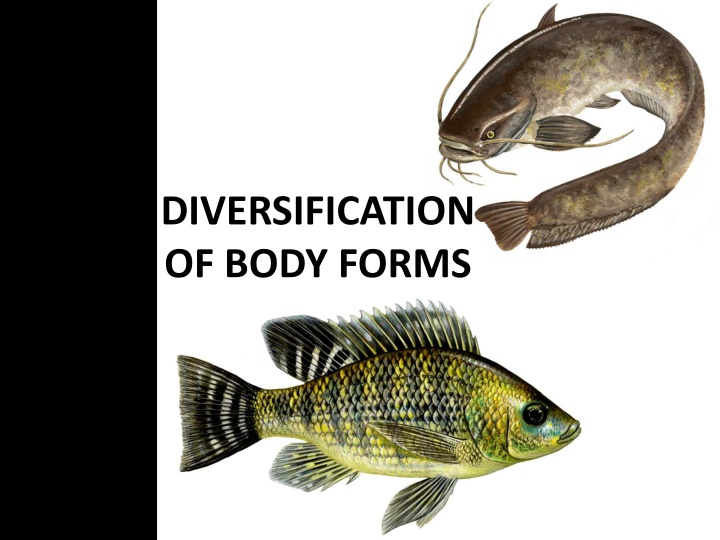Diversification of Body Forms: Oreochromis Niloticus
Anatomical features and characteristics of Oreochromis Niloticus, a species of cichlid fish known for its unique body shape, feeding habits, and economic importance. Learn about its physical traits, behaviors, and potential role in combating malaria through mosquito larvae consumption.
Download Presentation

Please find below an Image/Link to download the presentation.
The content on the website is provided AS IS for your information and personal use only. It may not be sold, licensed, or shared on other websites without obtaining consent from the author.If you encounter any issues during the download, it is possible that the publisher has removed the file from their server.
You are allowed to download the files provided on this website for personal or commercial use, subject to the condition that they are used lawfully. All files are the property of their respective owners.
The content on the website is provided AS IS for your information and personal use only. It may not be sold, licensed, or shared on other websites without obtaining consent from the author.
E N D
Presentation Transcript
DIVERSIFICATION OF BODY FORMS
Oreochromis niloticus (Burchell, 1822) Etymology: Oreochromis: Latin, aurum = gold + Greek, chromis = a fish, perhaps a perch. Classification Actinopterygii (ray-finned fishes) Perciformes (Perch-likes) Cichlidae (Cichlids) Oreochromis niloticus (Burchell, 1822)
Oreochromis niloticus (Burchell, 1822) Dorsal spines: 15 - 18 Dorsal soft rays: 11-13 Anal spines: 3 Anal soft rays: 9-11 Vertebrae: 30-32 Spinous and soft ray parts of dorsal fin continuous. Caudal fin truncated
Oreochromis niloticus (Burchell, 1822)
Oreochromis niloticus (Burchell, 1822)
Oreochromis niloticus (Burchell, 1822) Body compressed; caudal peduncle depth equal to length. Scales cycloid. Lateral line interrupted. Colouration Colour in spawning season, pectoral, dorsal and caudal fins becoming reddish caudal fin with numerous black bars. Most distinguishing characteristic is the presence of regular vertical stripes throughout depth of caudal fin.
Oreochromis niloticus (Burchell, 1822) The Nile tilapia is an omnivore that feeds on both plankton and aquatic plants and macrophytes It generally feeds in shallow waters thrives on the warmer temperatures commonly found in shallow waters compared to the colder environment of the deep lake. The Nile tilapia typically feeds during daytime hours.
Oreochromis niloticus (Burchell, 1822) Adults - 60 cm in length and up to 4.3 kg lives for up to 9 years tolerates brackish water and survives temperatures between 8 and 42 C high economic value and is widely introduced outside its natural range most commonly cultured cichlid feed on mosquito larvae, making it a possible tool in the fight against malaria in Africa
Clarias gariepinus (Burchell, 1822) Etymology: Clarias: Greek, chlaros = lively, in reference to the ability of the fish to live for a long time out of water; gariepinus: Named after its type locality, the Gariep river, the Hottentot name for the Orange river, South Africa. Classification Actinopterygii (ray-finned fishes Siluriformes (catfish) Clariidae (airbreathing catfishes) Clarias gariepinus (Burchell, 1822)
Clarias gariepinus (Burchell, 1822) Dorsal spines (total): 0; Dorsal soft rays (total): 61- 80; Anal spines: 0; Anal soft rays: 45 - 65; Vertebrae: 56 - 63. 4 pairs of barbles;
Clarias gariepinus (Burchell, 1822)
Clarias gariepinus (Burchell, 1822)
Clarias gariepinus (Burchell, 1822)
Clarias gariepinus (Burchell, 1822) Head shape - between rectangular and pointed in dorsal outline eyes supero-lateral and relatively small dorsal fin almost reaches caudal fin
Clarias gariepinus (Burchell, 1822) pectoral fin extends from operculum to below 1st dorsal fin rays; pectoral spine robust, serrated only on its outer face, the number of serrations increasing with age; lateral line appears as a small, white line from posterior end of head to middle of caudal fin base.
Clarias gariepinus (Burchell, 1822) Coloration: 2 colour patterns: Uniform dorsal surface and flanks and dorsal parts of pectoral and pelvic fins are dark greyish-greenish black belly and ventral parts of paired fins are lightly coloured marbled pattern irregular dark blotches on light coloured background above and laterally belly and ventral parts of the paired fins are whitish
Clarias gariepinus Burchell, 1822) Distribution throughout Africa and the Middle East freshwater lakes, rivers, and swamps, as well as human-made habitats Habits nocturnal - feeds on living and dead, animal matter. able to swallow relatively large prey whole crawl on dry ground to escape drying pools. E.g. common moorhen
Clarias gariepinus (Burchell, 1822) survive in shallow mud for long periods sometimes produce loud croaking sounds
You will be able to describe the external features of Catfish and Tilapia Drawings and Labeling are essential























